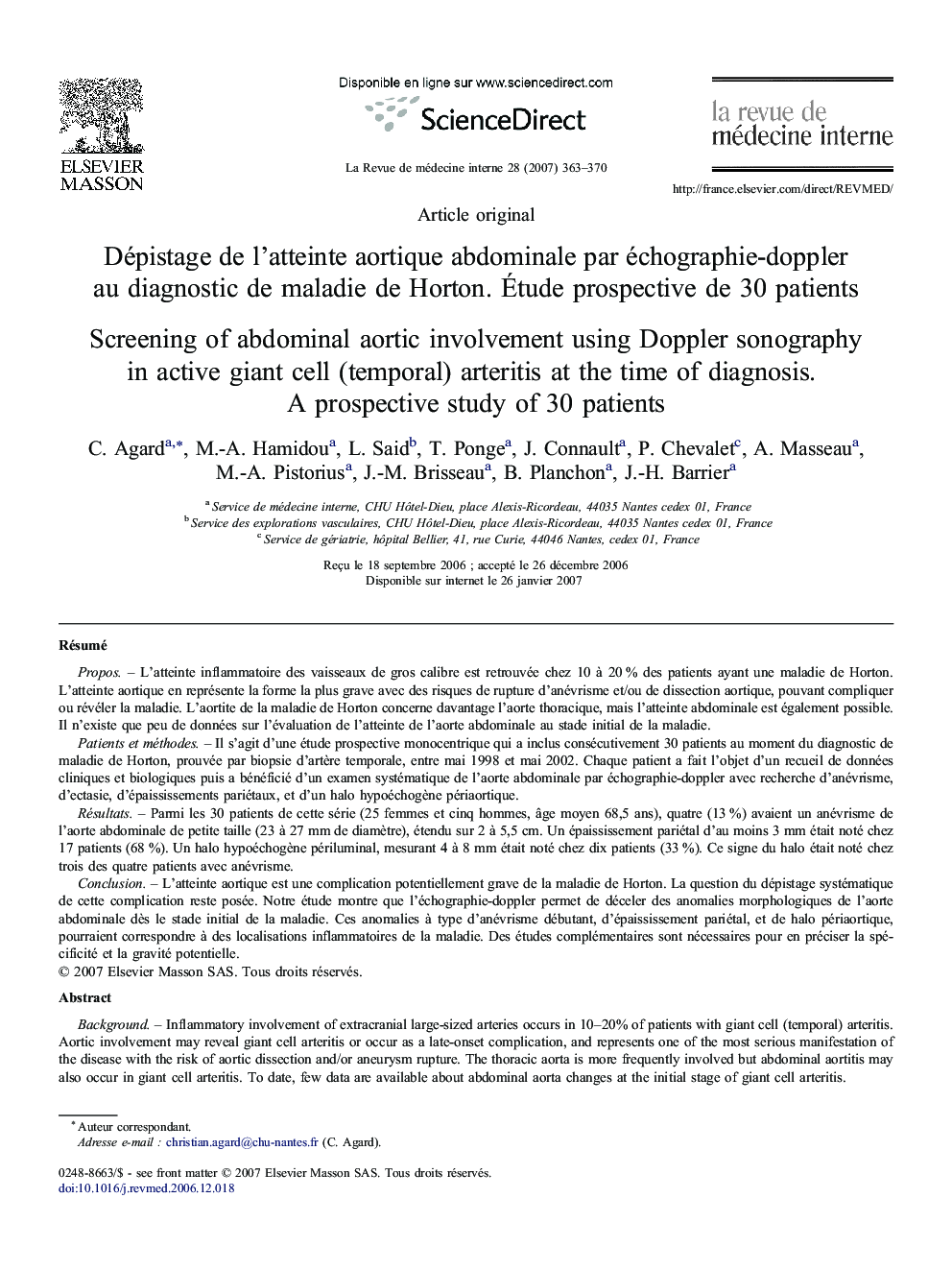| کد مقاله | کد نشریه | سال انتشار | مقاله انگلیسی | نسخه تمام متن |
|---|---|---|---|---|
| 3024420 | 1182534 | 2007 | 8 صفحه PDF | دانلود رایگان |

RésuméProposL'atteinte inflammatoire des vaisseaux de gros calibre est retrouvée chez 10 à 20 % des patients ayant une maladie de Horton. L'atteinte aortique en représente la forme la plus grave avec des risques de rupture d'anévrisme et/ou de dissection aortique, pouvant compliquer ou révéler la maladie. L'aortite de la maladie de Horton concerne davantage l'aorte thoracique, mais l'atteinte abdominale est également possible. Il n'existe que peu de données sur l'évaluation de l'atteinte de l'aorte abdominale au stade initial de la maladie.Patients et méthodesIl s'agit d'une étude prospective monocentrique qui a inclus consécutivement 30 patients au moment du diagnostic de maladie de Horton, prouvée par biopsie d'artère temporale, entre mai 1998 et mai 2002. Chaque patient a fait l'objet d'un recueil de données cliniques et biologiques puis a bénéficié d'un examen systématique de l'aorte abdominale par échographie-doppler avec recherche d'anévrisme, d'ectasie, d'épaississements pariétaux, et d'un halo hypoéchogène périaortique.RésultatsParmi les 30 patients de cette série (25 femmes et cinq hommes, âge moyen 68,5 ans), quatre (13 %) avaient un anévrisme de l'aorte abdominale de petite taille (23 à 27 mm de diamètre), étendu sur 2 à 5,5 cm. Un épaississement pariétal d'au moins 3 mm était noté chez 17 patients (68 %). Un halo hypoéchogène périluminal, mesurant 4 à 8 mm était noté chez dix patients (33 %). Ce signe du halo était noté chez trois des quatre patients avec anévrisme.ConclusionL'atteinte aortique est une complication potentiellement grave de la maladie de Horton. La question du dépistage systématique de cette complication reste posée. Notre étude montre que l'échographie-doppler permet de déceler des anomalies morphologiques de l'aorte abdominale dès le stade initial de la maladie. Ces anomalies à type d'anévrisme débutant, d'épaississement pariétal, et de halo périaortique, pourraient correspondre à des localisations inflammatoires de la maladie. Des études complémentaires sont nécessaires pour en préciser la spécificité et la gravité potentielle.
BackgroundInflammatory involvement of extracranial large-sized arteries occurs in 10–20% of patients with giant cell (temporal) arteritis. Aortic involvement may reveal giant cell arteritis or occur as a late-onset complication, and represents one of the most serious manifestation of the disease with the risk of aortic dissection and/or aneurysm rupture. The thoracic aorta is more frequently involved but abdominal aortitis may also occur in giant cell arteritis. To date, few data are available about abdominal aorta changes at the initial stage of giant cell arteritis.Patients and methodsThis prospective monocentric study was conducted between May 1998 and May 2002, and included 30 consecutive patients with biopsy-proven giant cell arteritis. Standard clinical and biological data were collected. Each patient underwent an abdominal aortic Doppler-sonography that looked for aneurysm, ectasia, thickening of the vascular wall, and hypoechoic halo around the aorta.ResultsAmong the 30 patients of this study (25 women, 5 men, mean age 68.5 years), 4 (13%) had an abdominal aortic aneurysm, with a low diameter (23 to 27 mm), measuring 2 to 5,5 cm in length. A vascular wall thickening superior or equal to 3 mm was noted in 17 patients (68%). A 4 to 8 mm periaortic hypoechoic halo was found in 10 patients (33%). This halo was present in 3 out of the 4 patients with aneurysm.ConclusionAortic involvement is a potentially serious complication of giant cell arteritis. The question of a systematic screening of this complication remains open to discussion. Our study shows that Doppler sonography may detect morphological abnormalities on the abdominal aorta at the initial stage of giant cell arteritis. These abnormalities comprise mild aneurysms, thickening of the vascular wall and periaortic halo, which could correspond to inflammatory locations of the disease. Complementary studies are needed to assess their specificity and their seriousness.
Journal: La Revue de Médecine Interne - Volume 28, Issue 6, June 2007, Pages 363–370